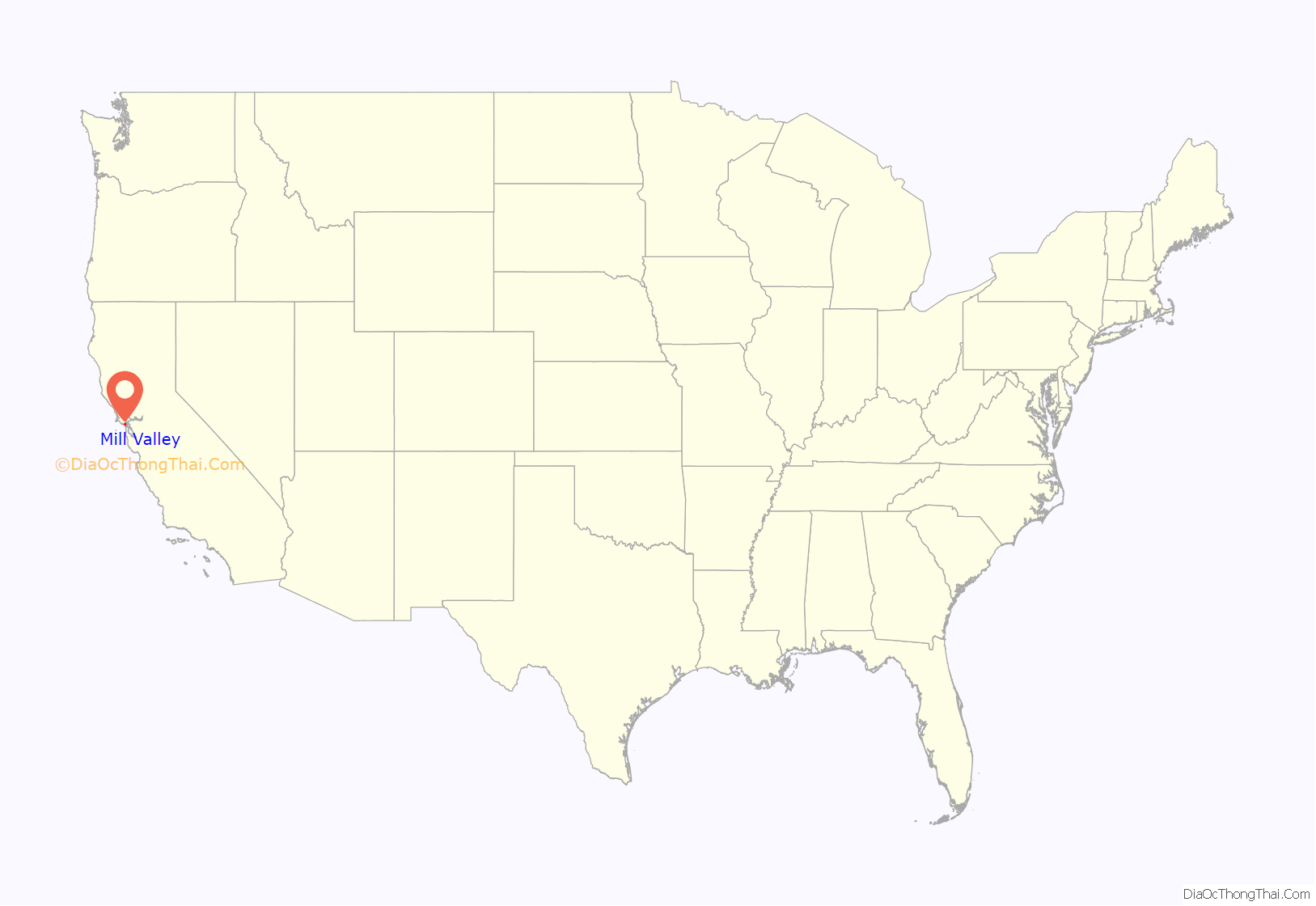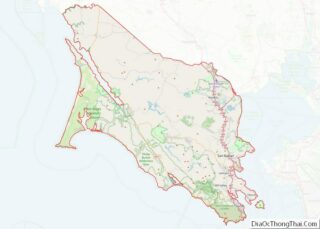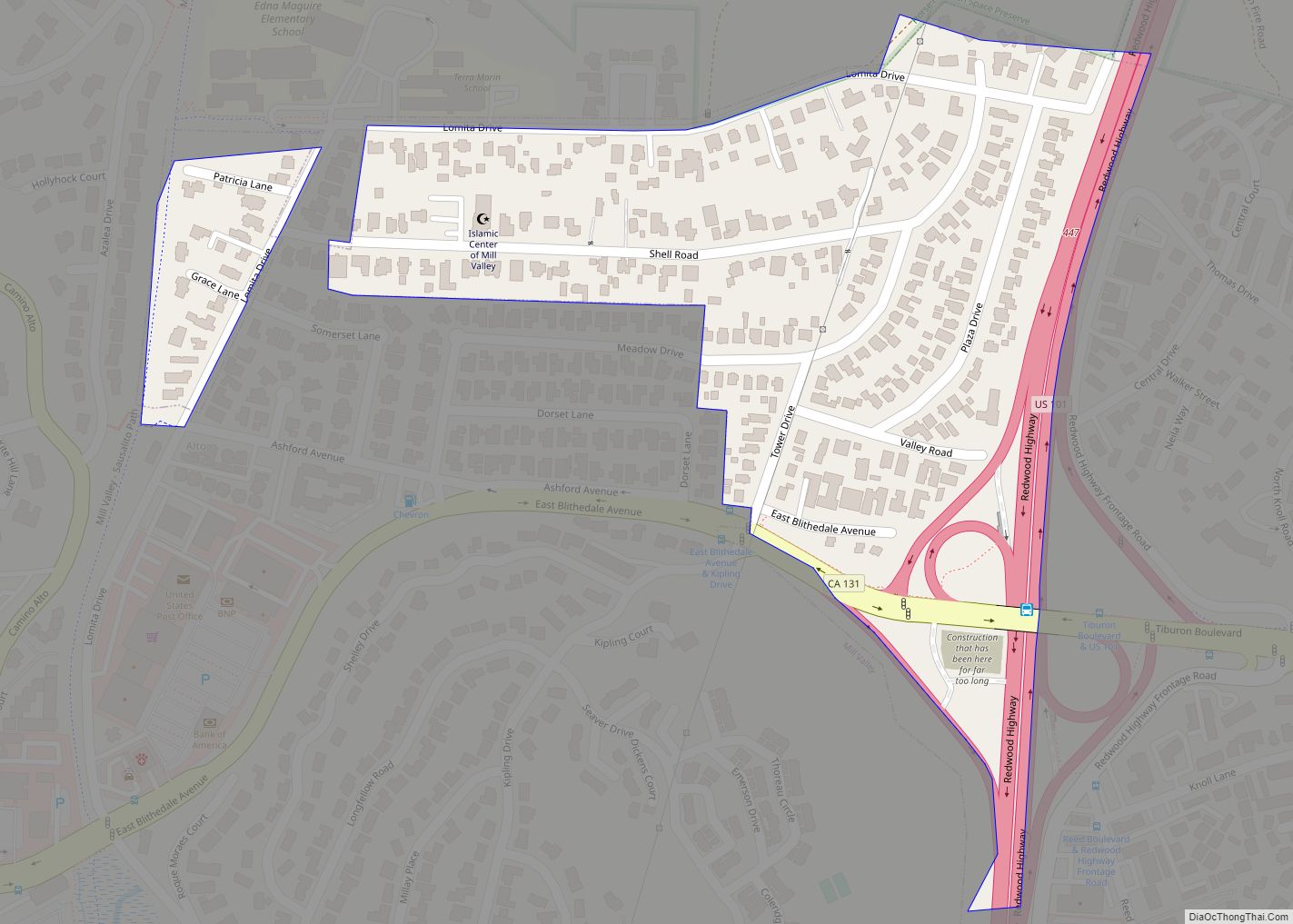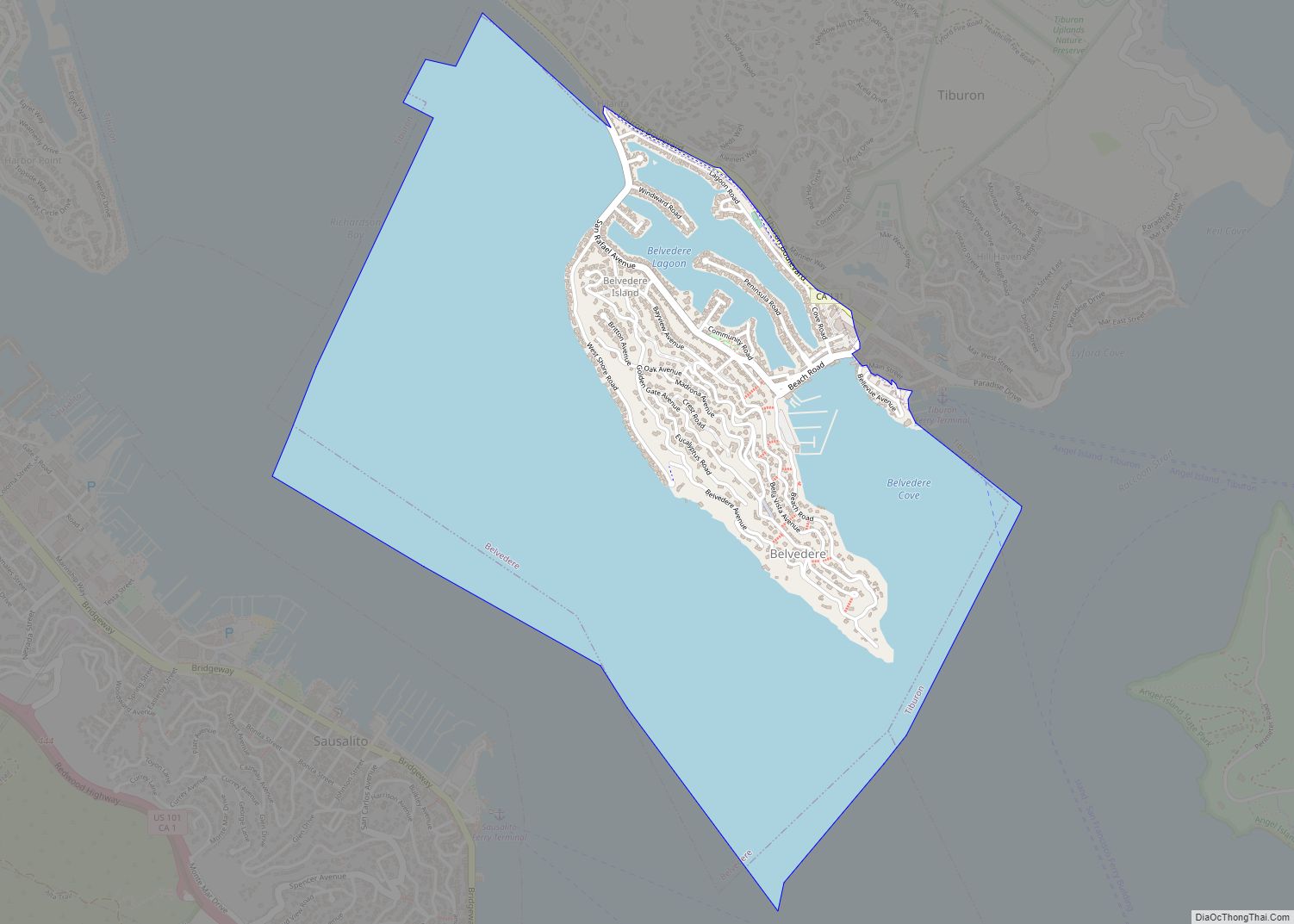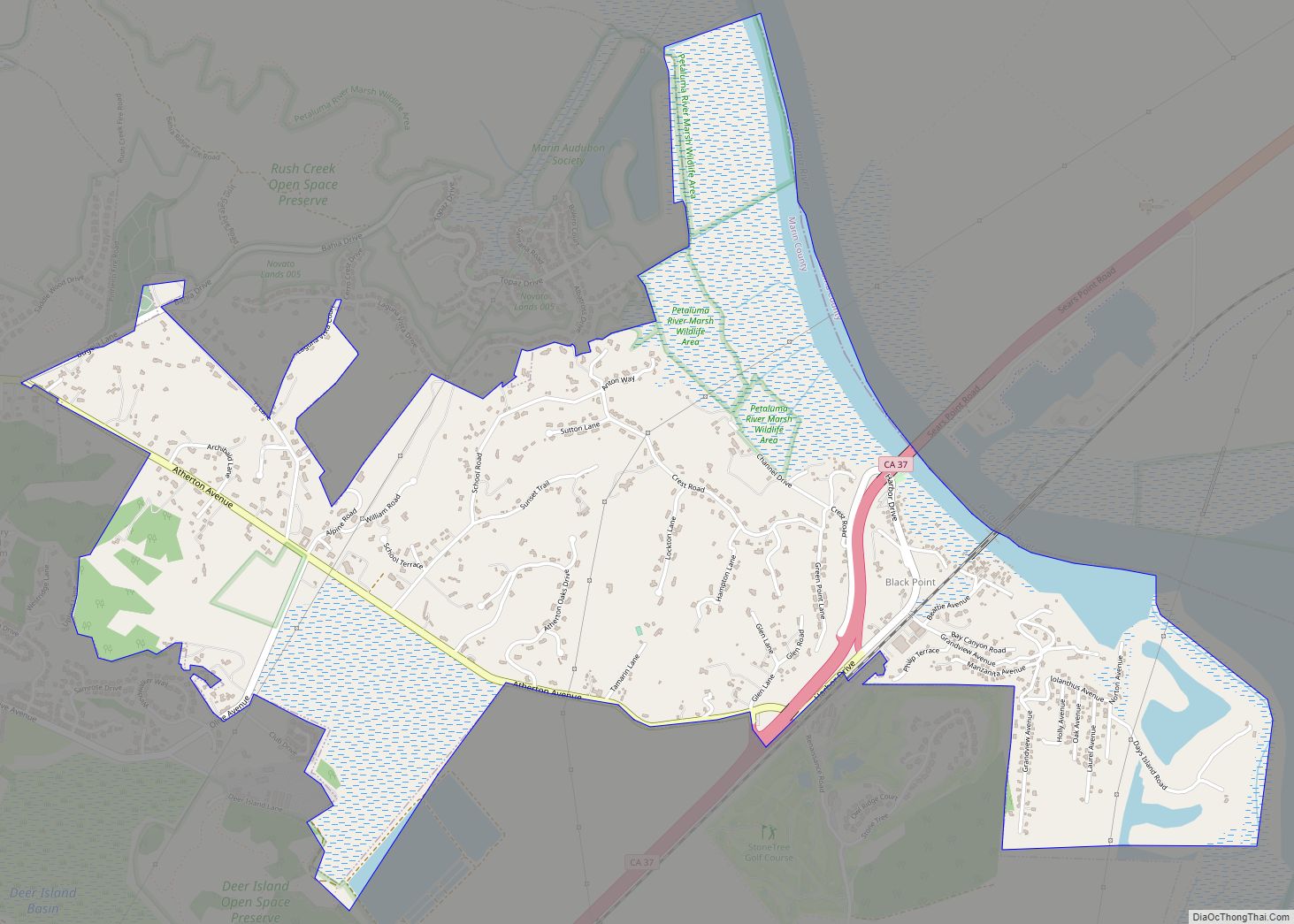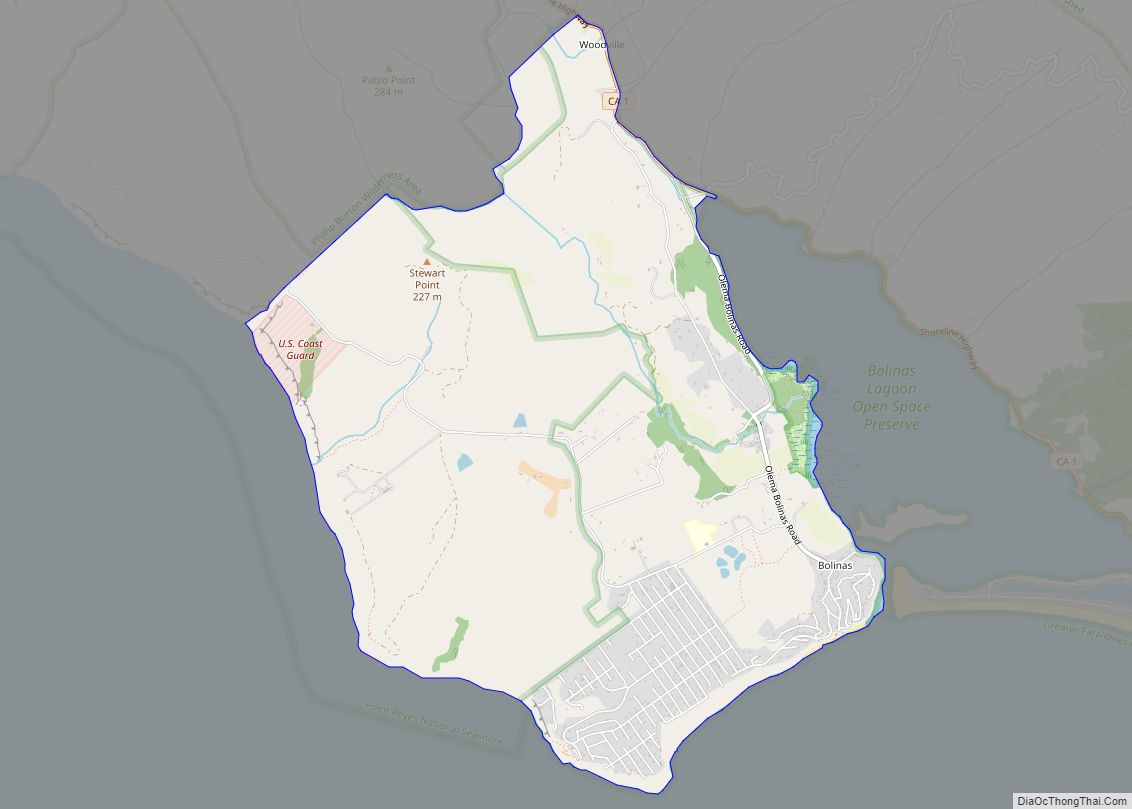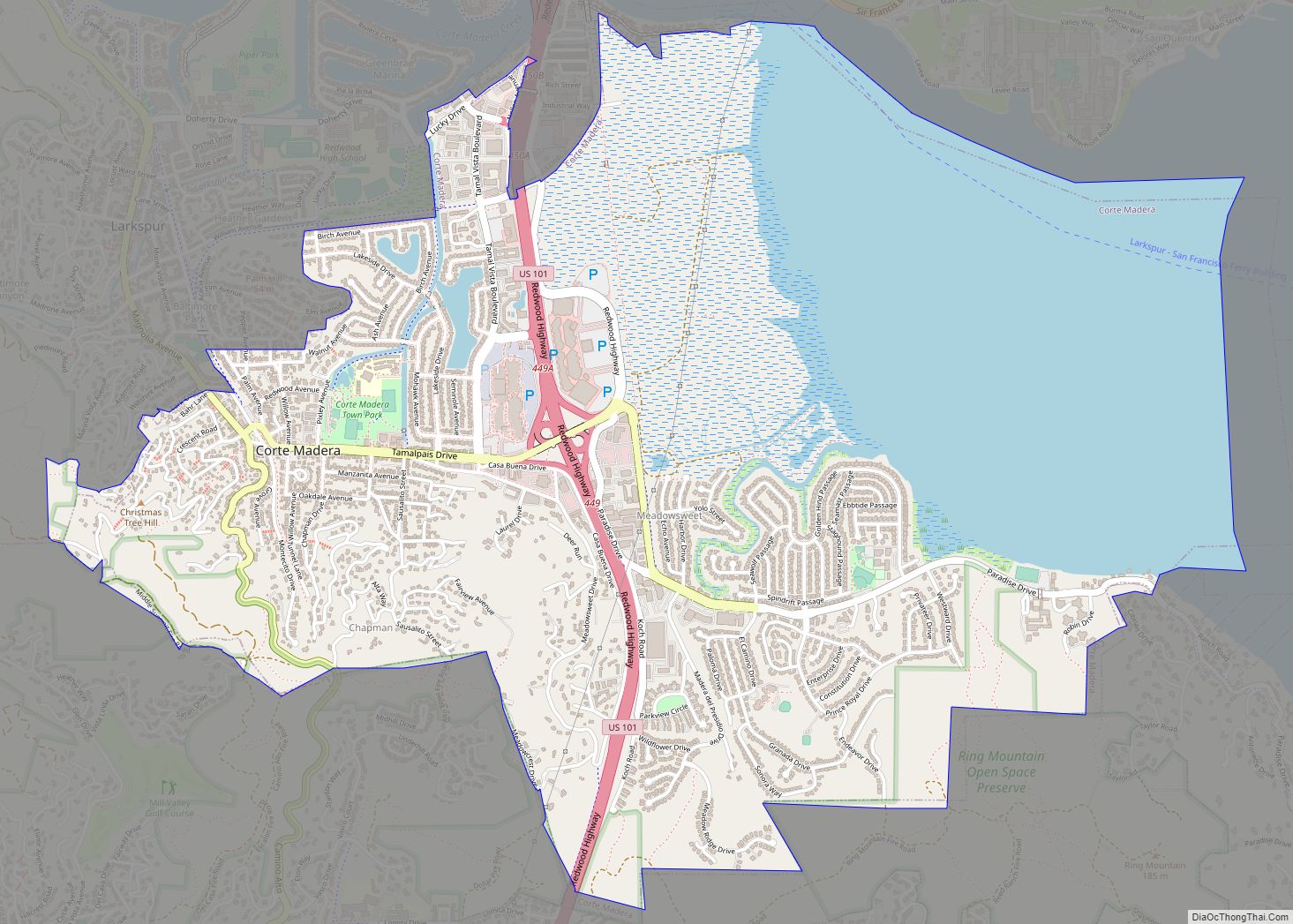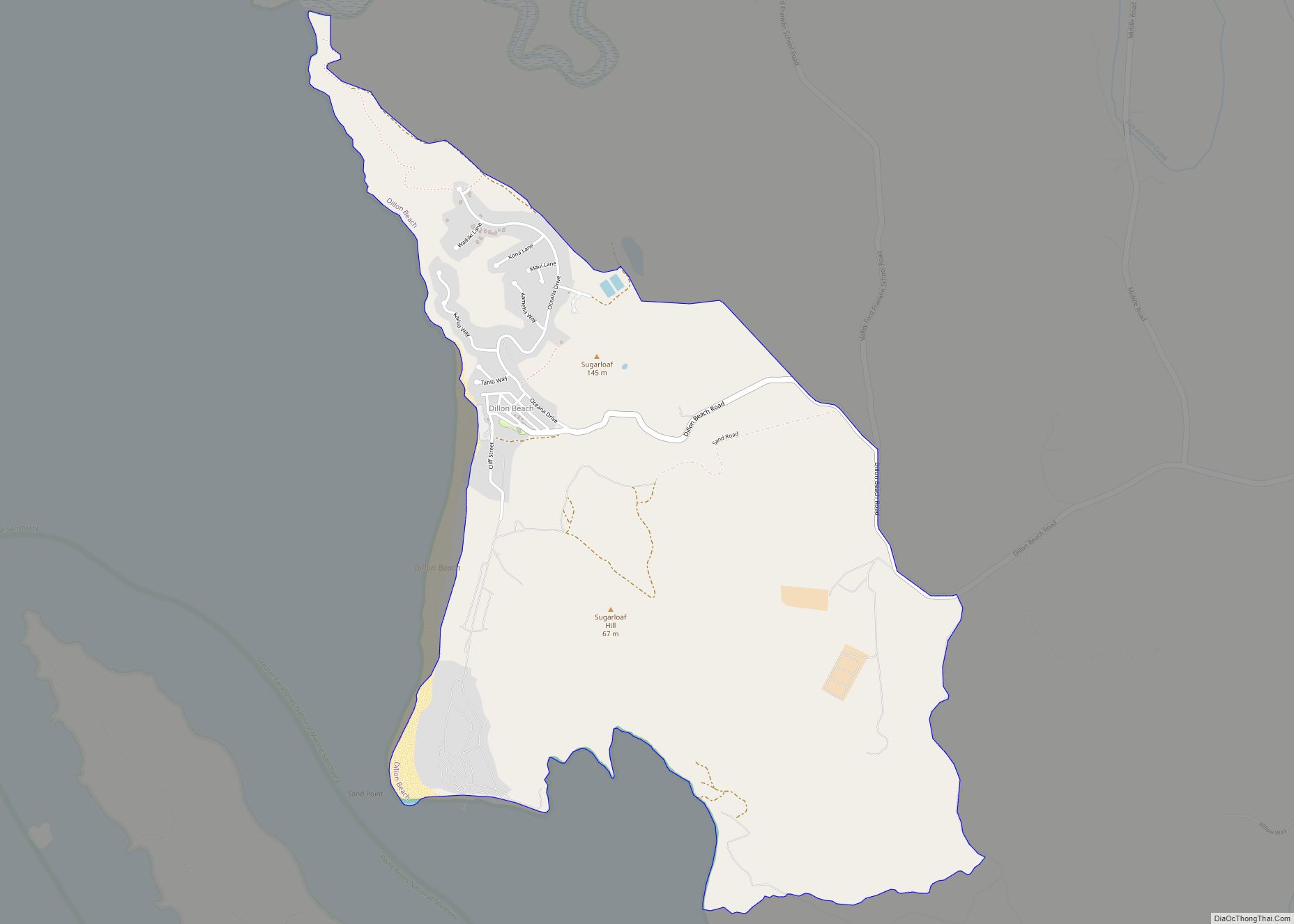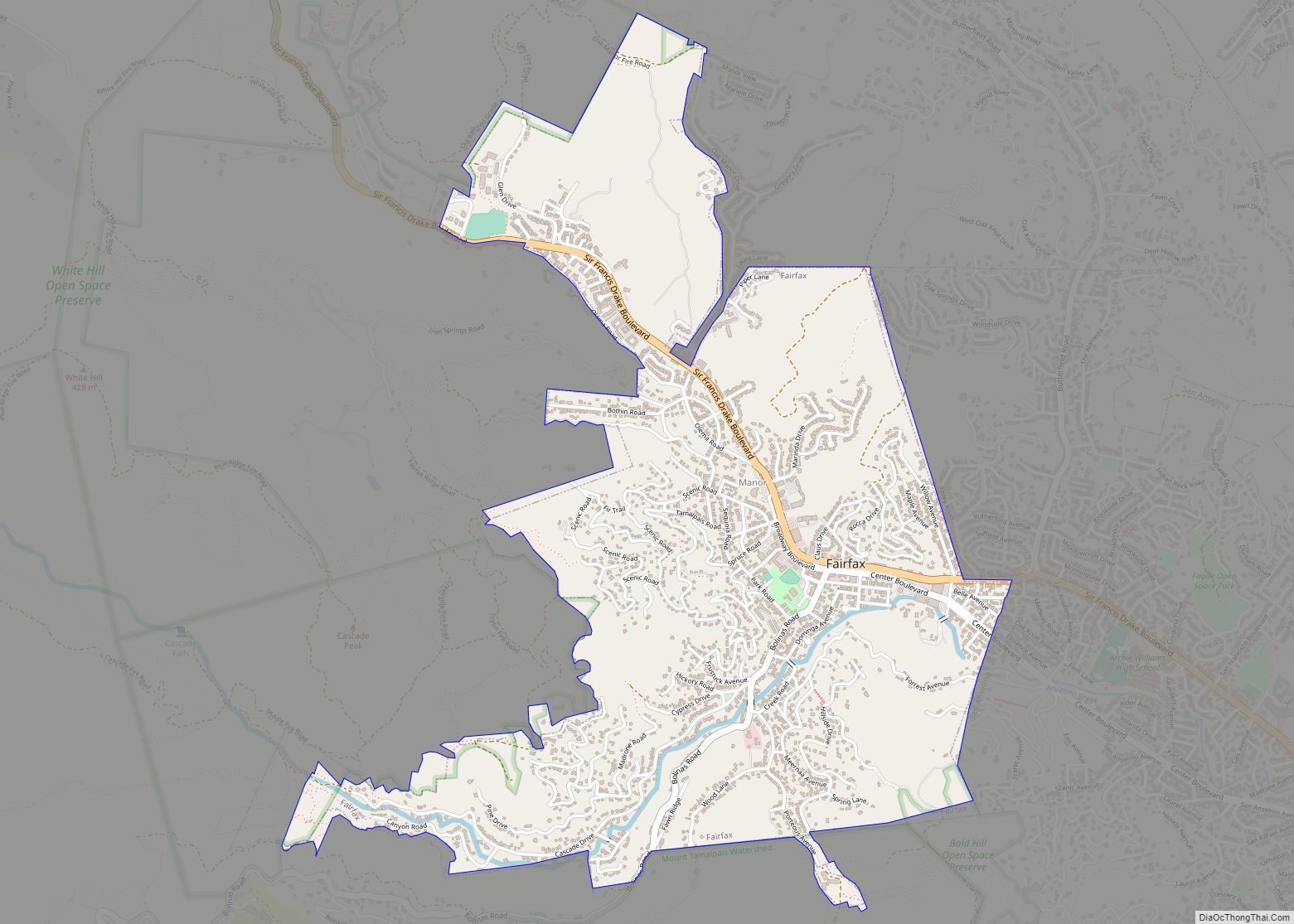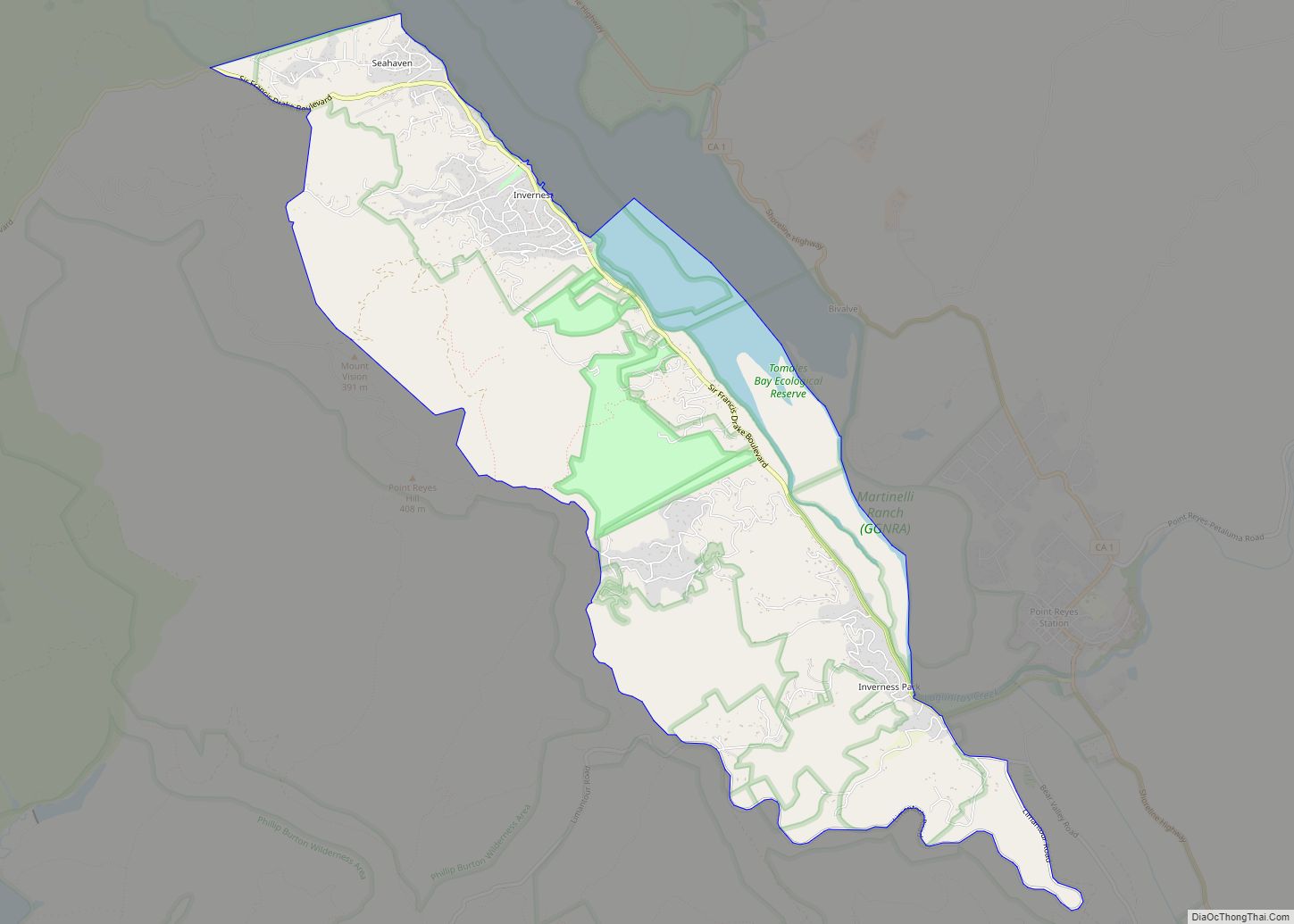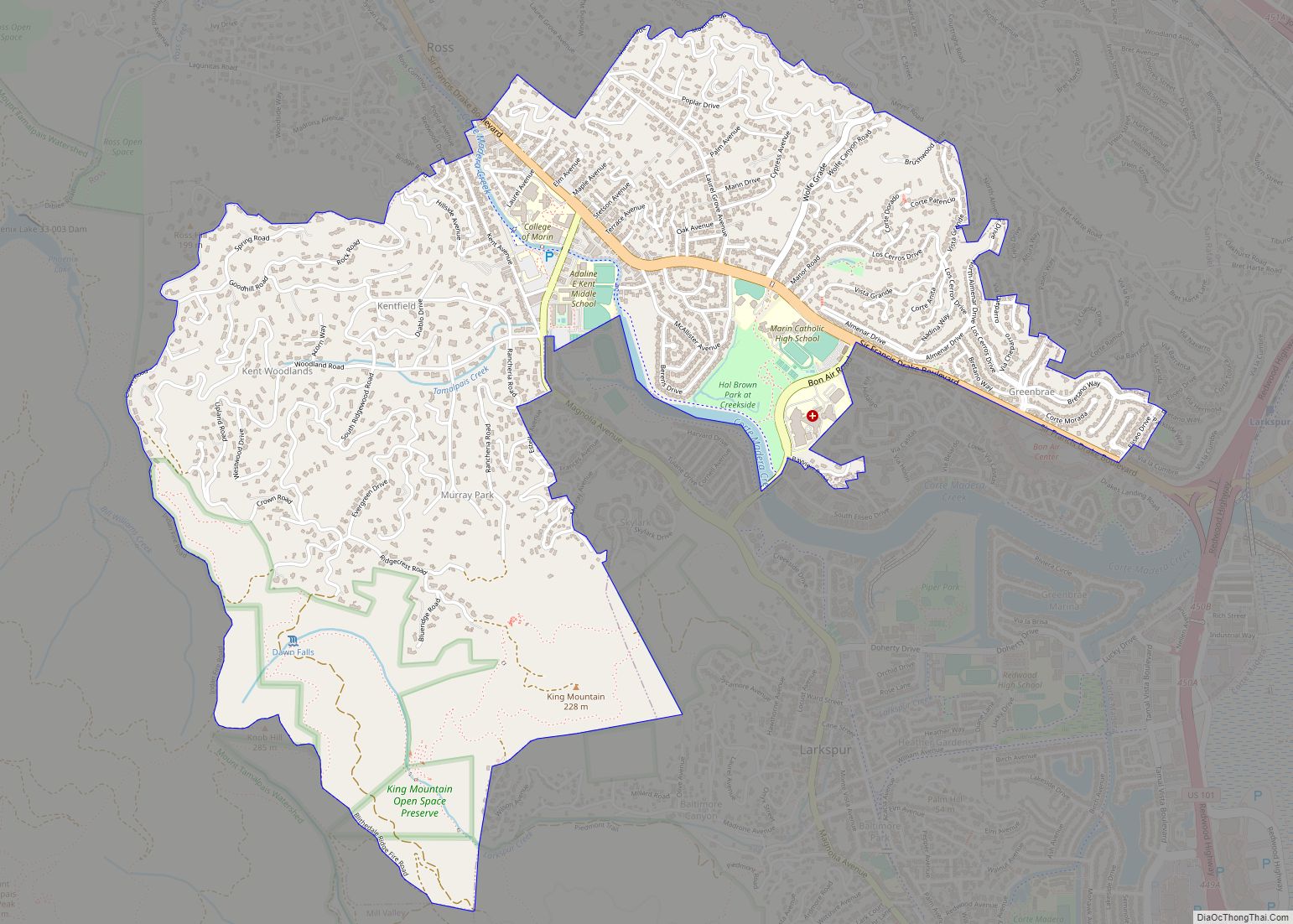Mill Valley is a city in Marin County, California, United States, located about 14 miles (23 km) north of San Francisco via the Golden Gate Bridge and 52 miles (84 km) from Napa Valley. The population was 14,231 at the 2020 census.
Mill Valley is located on the western and northern shores of Richardson Bay, and the eastern slopes of Mount Tamalpais. Beyond the flat coastal area and marshlands, it occupies narrow wooded canyons, mostly of second-growth redwoods, on the southeastern slopes of Mount Tamalpais. The Mill Valley 94941 ZIP Code also includes the following adjacent unincorporated communities: Almonte, Alto, Homestead Valley, Tamalpais Valley, and Strawberry. The Muir Woods National Monument is also located just outside the city limits.
| Name: | Mill Valley city |
|---|---|
| LSAD Code: | 25 |
| LSAD Description: | city (suffix) |
| State: | California |
| County: | Marin County |
| Incorporated: | September 1, 1900 |
| Elevation: | 79 ft (24 m) |
| Total Area: | 4.85 sq mi (12.55 km²) |
| Land Area: | 4.76 sq mi (12.34 km²) |
| Water Area: | 0.08 sq mi (0.22 km²) 1.74% |
| Total Population: | 14,231 |
| Population Density: | 2,993.7/sq mi (1,155.88/km²) |
| FIPS code: | 0647710 |
| Website: | www.cityofmillvalley.org |
Online Interactive Map
Click on ![]() to view map in "full screen" mode.
to view map in "full screen" mode.
Mill Valley location map. Where is Mill Valley city?
History
Coast Miwok
The first people known to inhabit Marin County, the Coast Miwok, arrived approximately 6,500 years ago. The territory of the Coast Miwok included all of Marin County, north to Bodega Bay and southern Sonoma County. More than 600 village sites have been identified, including 14 sites in the Mill Valley area. Nearby archaeological discoveries include the rock carvings and grinding sites on Ring Mountain. The pre-Missionization population of the Coast Miwok is estimated to be between 1,500 (Alfred L. Kroeber’s estimate for the year 1770 A.D.) to 2,000 (Sherburne F. Cook’s estimate for the same year). The pre-Missionization population of the Coast Miwok may have been as high as 5,000. Cook speculated that by 1848 their population had decreased to 300, and was down to 60 by 1880. As of 2011 there are over 1,000 registered members of the Federated Indians of Graton Rancheria, which includes both the Coast Miwok and the Southern Pomo, all of whom can date their ancestry back to the 14 survivors original tribal ancestors.
In Mill Valley, on Locust Avenue between Sycamore and Walnut Avenues, there is now a metal plaque set in the sidewalk in the area believed to be the birthplace of Chief Marin in 1781; the plaque was dedicated on May 8, 2009. The village site was first identified by Nels Nelson in 1907 and his excavation revealed tools, burials and food debris just beyond the driveway of 44 Locust Ave. At that time, the mound was 20 feet (6.1 m) high. Another famous Mill Valley site was in the Manzanita area underneath the Fireside Inn (previously known as the Manzanita Roadhouse, Manzanita Hotel, Emil Plasberg’s Top Rail, and Top Rail Tavern, most of which were notorious Prohibition-era gin joints and brothels) located near the intersection of U.S. Route 101 and California State Route 1. Built in 1916, the “blind pig” roadhouse was outside the dry limits of the city itself. Shell mounds have been discovered in areas by streams and along Richardson Bay, including in the Strawberry and Almonte neighborhoods.
Beginning with the foundation of Mission San Francisco de Asís, commonly known as Mission Dolores, in 1776, the Coast Miwok of southern Marin began to slowly enter the mission, first those from Sausalito followed by those from areas now known as Mill Valley, Belvedere, Tiburon and Bolinas. They called themselves the “Huimen” people. At the mission they were taught the Catholic religion, lost their freedom, and three quarters died as a result of exposure to European diseases. As a result of the high death rate at Mission Dolores it was decided to build a new Mission San Rafael, built in 1817. Over 200 surviving Coast Miwok were taken there from Mission Dolores and Mission San Jose, including the 17 survivors of the Huimen Coast Miwok of the Richardson Bay Area. California Missions.
Early settlers
By 1834, the Mission era had ended and California was under the control of the Mexican government. They took Miwok ancestral lands, divided them and gave them to Mexican soldiers or relatives who had connections with the Mexican governor. The huge tracts of land, called ranchos by the Mexican settlers, or Californios, soon covered the area. The Miwoks who had not died or fled were often employed under a state of indentured servitude to the California land grant owners. That same year, the governor of Alta California, José Figueroa, awarded to John T. Reed the first land grant in Marin, Rancho Corte Madera del Presidio. Just west of that, Rancho Saucelito was transferred to William A. Richardson in 1838 after being originally awarded to Nicolas Galindo in 1835. William Richardson also married a well-connected woman; both he and Reed were originally from Europe. Richardson’s name was later applied to Richardson Bay, an arm of the San Francisco Bay that brushes up against the eastern edge of Mill Valley. The Richardson rancho contained everything south and west of the Corte Madera and Larkspur areas with the Pacific Ocean, San Francisco Bay, and Richardson Bay as the other three borders. The former encompassed what is now southern Corte Madera, the Tiburon Peninsula, and Strawberry Point.
In 1836, John Reed married Hilaria Sanchez, the daughter of a commandante in the San Francisco Presidio. He built the first sawmill in the county on the Cascade Creek (now Old Mill Park) in the mid-1830s on Richardson’s rancho and settled near what is now Locke Lane and LaGoma Avenue. The mill cut wood for the San Francisco Presidio. He raised cattle and horses and had a brickyard and stone quarry. Reed also did brisk businesses in hunting, skins, tallow, and other products until his death in 1843 at 38 years of age. Richardson sold butter, milk and beef to San Francisco during the Gold Rush. Shortly thereafter, he made several poor investments and wound up massively in debt to many creditors. On top of losing his Mendocino County rancho, he was forced to deed the 640-acre (2.6 km) Rancho Saucelito to his wife, Maria Antonia Martinez, daughter of the commandante of the Presidio, in order to protect her. The rest of the rancho, including the part of what is now Mill Valley that did not already belong to Reed’s heirs, was given to his administrator Samuel Reading Throckmorton. At his death in 1856 at 61 years old, Richardson was almost destitute.
Throckmorton came to San Francisco in 1850 as an agent for an eastern mining business before working for Richardson. As payment of a debt, Throckmorton acquired a large portion of Rancho Saucelito in 1853–54 and built his own rancho, “The Homestead,” on what is now Linden Lane and Montford Avenue. The descendants of ranch superintendent Jacob Gardner continue to be active in Marin. Some of the rest of his land was leased out for dairy farming to Portuguese settlers. A majority of the immigrants came from the Azores. Those who were unsuccessful at gold mining came north to the Marin Headlands and later brought their families. In Mill Valley, Ranch “B” is one of the few remaining dairy farm buildings and is located near the parking lot at the Tennessee Valley trailhead. Throckmorton also suffered devastating financial problems before his death in 1887. His surname would later be applied to one of the major thoroughfares in Mill Valley. Richardson and Reed had never formalized the boundary lines separating their ranchos. Richardson’s heirs successfully sued Reed’s heirs in 1860 claiming the mill was built on their property. The border was officially marked as running along the Arroyo Corte Madera del Presidio along present-day Miller Avenue. Everything to the east of the creek was Reed property, and everything to the west was Richardson land. It was Richardson’s territory that would soon become part of Mill Valley when Throckmorton’s daughter Suzanna was forced to relinquish several thousand acres to the San Francisco Savings & Union Bank to satisfy a debt of $100,000 against the estate in 1889.
In 1873, San Francisco physician Dr. John Cushing discovered 320 “lost” acres between the Reed and Richardson boundaries between present-day Corte Madera Avenue, across the creek, and into West Blithedale Canyon. Using the Homestead Act he petitioned the government and managed to acquire the land. Before his death in 1879 he had built a sanitarium in the peaceful canyon. In Sausalito the North Pacific Coast Railroad had laid down tracks to a station near present-day Highway 101 at Strawberry. Seeing the financial advantages of a railroad his descendants then turned the hospital into the Blithedale Hotel after the land title was finally granted in 1884. The sanitarium was enlarged, cottages were built up along the property, and horse-drawn carriages were purchased to pick up guests at the Alto station. Within a few years, several other summer resort hotels had cropped up in the canyon including the Abbey, the Eastland, and the Redwood Lodge. Fishing, hunting, hiking, swimming, horseback riding, and other activities increased in popularity as people came to the area as vacationers or moved in and commuted to San Francisco for work. Meanwhile, Reed’s mill deforested much of the surrounding redwoods, meaning that most of the redwoods growing today are second- or third-growth. The King family (King Street) owned property near the Cushing land. One of its buildings was a small adobe house which is believed to have predated the King farm. The Blithedale Hotel used it as a milk house. The adobe structure is still standing and connected to a house on West Blithedale Avenue; it is the oldest structure in Mill Valley.
The San Francisco Savings & Union Bank organized the Tamalpais Land & Water Company in 1889 as an agency for disposing of the Richardson land gained from the Throckmorton debt. The Board of Directors was President Joseph Eastland, Secretary Louis L. Janes (Janes Street), Thomas Magee (Magee Avenue), Albert Miller (Miller Avenue), and Lovell White (Lovell Avenue). Eastland, who had been president of the North Pacific Coast Railroad in 1877 and retained an interest, pushed to extend the railroad into the area in 1889. Though Reed, Richardson, and the Cushings were crucial to bringing people to the Mill Valley area, it was Eastland who really propelled the area and set the foundation for the city today. He had founded power companies all around the San Francisco Bay area, was on the board of several banks, and had control of several commercial companies. The Tamalpais Land & Water Co. hired Michael M. O’Shaughnessy, already a noted engineer to lay out roads, pedestrian paths, and step-systems for what the developers hoped would become a new city. He also built the Cascade Dam & Reservoir for water supply, and set aside land plots for churches, schools, and parks.
On May 31, 1890, nearly 3,000 people attended The Tamalpais Land & Water Co. land auction near the now-crumbling sawmill. More than 200 acres (0.81 km) were sold that day in the areas of present-day Throckmorton, Cascade, Lovell, Summit, and Miller Avenues and extending to the west side of Corte Madera Avenue. By 1892, there were two schools in the area and a few churches. The auction also brought into Mill Valley architects, builders, and craftsmen. Harvey A. Klyce was one of the most prominent of the architects and designed many private homes and public buildings in the area, including the Masonic Lodge in 1904. Before his death in 1894, Eastland built a large summer home, “Burlwood”, constructed on Throckmorton Avenue in 1892 that still stands though much of the original land has been parceled off. Burlwood was the first home in the town to have electricity, and when telephones were installed only he and Mrs. Cushing, the owner of the Blithedale Hotel, had service. After the land auctions the area was known as both “Eastland” and “Mill Valley”.
Janes, by then the resident director of Tamalpais Land & Water Co. (and eventually the city’s first town clerk), and Sidney B. Cushing, president of the San Rafael Gas & Electric Co. set out to bring a railroad up Mt. Tamalpais. The Mt. Tamalpais Scenic Railway opened in 1896 (with Cushing as President) and ran from the town center (present day Lytton Square) all the way to the summit. In 1907, the railroad added a branch line into “Redwood Canyon”, and in 1908, the canyon became Muir Woods, a national monument. The railroad built the Muir Inn (with a fine restaurant) and overnight cabins for visitors. The Mt. Tamalpais & Muir Woods Scenic Railway, “The Crookedest Railroad in the World” and its unique Gravity Cars brought thousands of tourists to the Tavern of Tamalpais on the mountain summit (built in 1896, rebuilt after the 1923 fire, and razed in 1950 by the California State Parks), the West Point Inn (built in 1904, by the scenic railway, operated commercially until 1943, closed briefly and then run by volunteers to present day, ), and the Muir Woods Inn (burned in 1913, rebuilt in 1914, destroyed in 1930). The tracks were removed in 1930 after the 1929 fire. This occurred as a result of a drop in ridership due to increased usage of automobiles rather than trains for recreation and construction of the Panoramic Highway and connecting road to Ridgecrest in 1929. Rails connected Mill Valley with neighboring cities and commuters to San Francisco via ferries.
Incorporation through WWII
By 1900, the population was nearing 900 and the locals pushed out the Tamalpais Land & Water Co. in favor of incorporation. Organizations and clubs cropped up including the Outdoor Art Club (1902) (organized by Laura Lyon White), Masonic Lodge (1903) which celebrated its centennial in 2003 and the Dipsea Race (1905), the latter marking its 100th anniversary in 2010. The second big population boom came after the 1906 Great earthquake. While much of San Francisco and Marin County was devastated, many fled to Mill Valley and most never left. In that year alone the population grew to over 1,000 permanent residents. Creeks were bridged over or dammed, more roads laid down and oiled, and cement sidewalks poured. Tamalpais High School opened in 1908, the first city hall was erected in 1908, and Andrew Carnegie’s library in 1910. The Post Office opened under the name “Eastland”, however after many objections it was changed to “Mill Valley” in 1904. The very first Mountain Play was performed at the Mountain Theater on Mt. Tam in 1913.
By the 1920s, most roads were paved over, mail delivery was in full swing, and the population was at its highest at more than 2,500 citizens. Mill Valley Italian settlers made wine during Prohibition, while some local bar owners made bootleg whiskey under the dense foliage around the local creeks. January 1922 saw the first of several years of snow in Marin County, coating Mt. Tam white. Two years later the Sulphur Springs, a natural hot spring where locals could revive their lagging spirits, was covered over and turned in the playground of the Old Mill Elementary School.1929 was a year of great change for Mill Valley. The Great Fire raged for several days in early July and nearly destroyed the fledgling city. It ravaged much of Mt. Tam (including the Tavern and 117 homes) and the city itself was spared only by a change in wind direction. In October of that year, the Mt. Tamalpais and Muir Woods Scenic Railway ran for the last time. The fire caused great devastation to tourism and tourist destinations, but the railroads were also crushed by the automobile. Panoramic Highway, running between Mill Valley and Stinson Beach was built in 1929–1930. The stock market crash of 1929 and the ensuing Great Depression crippled what little railroad tourism there was to the point where the tracks were eventually taken up in 1931.
During the Great Depression, many famous local landmarks were constructed with the help of the Works Progress Administration and the Civilian Conservation Corps, including the Mead Theater at Tam High (named after school board Trustee Ernest Mead), the Mountain Theater rock seating, and the Golden Gate Bridge in 1934–1937. The latter event suspended ferry commuting between Marin and the city from 1941 through 1970 and helped increase the Marin population. With the demise of the railroads came the introduction of local bus service. Greyhound moved into the former train depot in Lytton Square in October 1940. In Sausalito, Marinship brought over 75,000 people to Marin, many of whom moved to Mill Valley permanently. At the height of the War, nearly 400 locals were fighting, including many volunteer firemen and government officials. By 1950, 1 in 10 Mill Valleyans were living in a “Goheen Home”. George C. Goheen built the so-called “defense homes” for defense workers throughout the 1940s and 1950s in the Alto neighborhood.
1950s to present
With a population just over 7,000 by 1950, Mill Valley was still relatively rural. Men commuted to San Francisco on the Greyhound bus when the streets were not flooding in heavy rain, and there still were not any traffic lights. The military built the Mill Valley Air Force Station to protect the area during the Korean War. In 1956, a group of Beat poets and writers lived briefly in the Perry house, most notably Jack Kerouac and San Francisco Renaissance Beat poet Gary Snyder. The house and its land is now owned by the Marin County Open Space District. By the beginning of the 1960s, however, the population swelled. The Mill Valley Fall Arts Festival became a permanent annual event and the old Carnegie library was replaced with an award-winning library at 375 Throckmorton Ave. Designed by architect Donn Emmons, the new library was formally dedicated on September 18, 1966. The 1970s saw a change in attitude and population. Mill Valley became an area associated with great wealth, with many people making their millions in San Francisco and moving north. New schools and neighborhoods cropped up, though the city maintained its defense of redwoods and protected open space.
Cascade Dam, built in 1893, was closed in 1972 and drained four years later in an attempt to curb the “hordes” of young people using the reservoir for nude sunbathing and swimming. Youth subculture would come under attack again in 1974 when the City Council banned live music, first at the Sweetwater and later at the Old Mill Tavern, both now defunct. In 1977, the Lucretia Hanson Little History Room in the library opened and became the base of operations for the Mill Valley Historical Society. Marin County was hit with one of the worst droughts on record beginning in 1976 and peaking in 1977, brought on by a combination of several seasons of low rainfall and a refusal to import water from the Russian River, instead relying solely on rain water from Mt. Tam and the West Marin watersheds to fill the then-six reservoirs. By June 1977, the County managed to pipe in water from the Sacramento River Delta, staving off disaster. The rainfall during the winter of 1977-78 was one of the heaviest on record. The Mill Valley Film Festival, now part of the California Film Institute, began in 1978 at the Sequoia Theatre.
The 1980s and 1990s saw the decline of small businesses in Mill Valley. Local establishments like Lockwood’s Pharmacy closed in 1981 after running almost continuously for 86 years. Old Mill Tavern, O’Leary’s, and the Unknown Museum shut their doors, as did Red Cart Market and Tamalpais Hardware. In their places came boutiques, upscale clothing stores, coffee shops, art galleries, and gourmet grocery stores. Downtown Plaza and Lytton Square were remodeled to fit the new attitude. The population in the city alone swelled over 13,000 and many of the old, narrow, winding streets grew clogged with traffic congestion. The Public Library expanded with a new Children’s Room, a downstairs Fiction Room, and Internet computers. It also joined MARINet, a consortium of all the public libraries in Marin, to allow patrons greater access to information. MARINet now has an online catalogue of all the materials, both physical and electronic, in the Marin public libraries, which patrons can order, pick up, and drop off materials at any of the participating libraries. The Old Mill also got a facelift; it was rebuilt to the same specifications as the original in 1991. The 1990s also saw another influx of affluence. Many new homeowners gutted homes built in the 19th and early 20th centuries or tore them down altogether.
The dawn of the new millennium brought reflection on the past, as the city celebrated 100 years of incorporation. Soon after Mill Valley got its brand new Community Center at 180 Camino Alto, adjacent to Mill Valley Middle School.
On January 31, 2008, Mill Valley’s sewage treatment plant spilled 2.45 million gallons of sewage into the San Francisco Bay. This marked the second such spill in Mill Valley within a week (the previous one spilled 2.7 million gallons), and the most recent of several that occurred in Marin County in early 2008. Mill Valley’s treatment plant attributed the spills to “human error”. The spills caused distress in Mill Valley’s administrative government, which remains outspoken about “dedicating itself to the protection of air quality, waste reduction, water and energy conservation, and the protection of wildlife and habitat” in Mill Valley.
Highlights of 2010-2020 decade included a major renovation of Miller Avenue known as the Miller Avenue Streetscape project which finished in 2018. This was followed by the restoration of the historic Mill Valley paper mill, resulting in new public space, shopping, and restaurants located a short walk from downtown.
Mill Valley Road Map
Mill Valley city Satellite Map
Geography
According to the United States Census Bureau the city has a total area of 4.8 square miles (12 km), of which 4.7 square miles (12 km) is land and 0.1 square miles (0.26 km) of (1.74%) water.
The Mill Valley 94941 area lies between Mt. Tamalpais on the west, the city of Tiburon on the east, the City of Corte Madera on the north, and the Golden Gate National Recreational Area (GGNRA) on the south. Two streams flow from the slopes of Mt. Tamalpais through Mill Valley to the bay: the Arroyo Corte Madera del Presidio; and Cascade Creek. Mill Valley is surrounded by hundreds of acres (hectares) of state, federal, and county park lands. In addition, there are many municipally maintained open-space reserves, parks, and coastal habitats which, when taken together, ensconce Mill Valley in a natural wilderness.
Mill Valley and the Homestead Valley Land Trust maintains many minimally disturbed wildland areas and preserves which are open to the public from sunrise to dusk every day. Several nature trails allow access as well as providing gateway access to neighboring state and federal park lands, and the Mt. Tamalpais Watershed wildland on the broad eastern face of Mt. Tamalpais that overlooks Mill Valley. These are undeveloped natural areas and contain many species of wild animals, including some large predators like the coyote, the bobcat, and the cougar.
Climate
Mill Valley has a mild Mediterranean climate which results in relatively wet winters and very dry summers. Winter lows rarely drop below freezing and summer highs rarely peak 90 °F (32 °C) with 90% of the annual rain falling in November through March. Wind speeds average lower than national averages in winter months and higher in summer, and often become quite gusty in the canyon regions of town. California coastal fog often affects Mill Valley, making relative humidity highly variable. The wetter winter months tend to make for a more consistent daily relative humidity around 70-90% (slightly higher than US averages). During the summer months, however, while the morning fog often keeps morning humidity normal, in a typical 70-80% range, by afternoon after the fog burns off, the humidity regularly plummets to around 30% as one would expect in this dry seasonal climate.
Mill Valley is also affected by microclimate conditions in the several box canyons with steep north-facing slopes and dense forests which span the southern and western city limits, which, along with the coastal fog, all conspire to make many of the dense forested regions of Mill Valley noticeably cooler and moister, on average, than other regions of town. This microclimate is what makes for the favorable ecology required by the Coastal Redwood forests which still cover much of the town and surrounding area, and have played such a pivotal role throughout the history of Mill Valley.
See also
Map of California State and its subdivision:- Alameda
- Alpine
- Amador
- Butte
- Calaveras
- Colusa
- Contra Costa
- Del Norte
- El Dorado
- Fresno
- Glenn
- Humboldt
- Imperial
- Inyo
- Kern
- Kings
- Lake
- Lassen
- Los Angeles
- Madera
- Marin
- Mariposa
- Mendocino
- Merced
- Modoc
- Mono
- Monterey
- Napa
- Nevada
- Orange
- Placer
- Plumas
- Riverside
- Sacramento
- San Benito
- San Bernardino
- San Diego
- San Francisco
- San Joaquin
- San Luis Obispo
- San Mateo
- Santa Barbara
- Santa Clara
- Santa Cruz
- Shasta
- Sierra
- Siskiyou
- Solano
- Sonoma
- Stanislaus
- Sutter
- Tehama
- Trinity
- Tulare
- Tuolumne
- Ventura
- Yolo
- Yuba
- Alabama
- Alaska
- Arizona
- Arkansas
- California
- Colorado
- Connecticut
- Delaware
- District of Columbia
- Florida
- Georgia
- Hawaii
- Idaho
- Illinois
- Indiana
- Iowa
- Kansas
- Kentucky
- Louisiana
- Maine
- Maryland
- Massachusetts
- Michigan
- Minnesota
- Mississippi
- Missouri
- Montana
- Nebraska
- Nevada
- New Hampshire
- New Jersey
- New Mexico
- New York
- North Carolina
- North Dakota
- Ohio
- Oklahoma
- Oregon
- Pennsylvania
- Rhode Island
- South Carolina
- South Dakota
- Tennessee
- Texas
- Utah
- Vermont
- Virginia
- Washington
- West Virginia
- Wisconsin
- Wyoming
